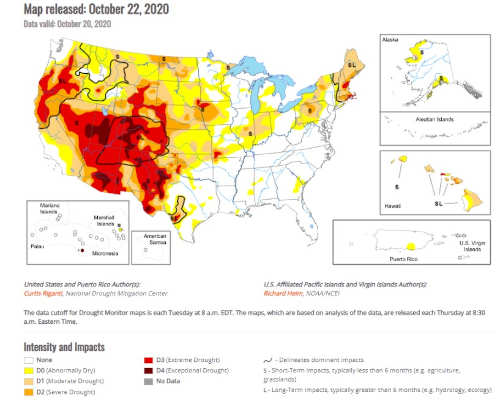By Claire Hutchins
Persistent dryness is both a blessing and a curse to winter wheat farmers across the U.S. Plains states. Dry conditions accelerated the autumn row crop harvest, which allowed for quick planting and of hard red winter (HRW) wheat, but critically low subsoil moisture levels in states like Kansas and Colorado may leave producers more vulnerable to unpredictable winter weather. According to USDA, 41% of the crop for harvest in 2021 is in good to excellent condition, below some analysts’ average expectations of 53% and 15 points below this time last year.
Here is a look at winter wheat planting and development conditions by state.
Texas. HRW planting progress is right on schedule with 72% of the crop in the ground. While dryness persists in the Texas Panhandle, overall crop condition is in line with last year at 37% good to excellent. HRW planted area in the state is expected to increase for the 2020/21 crop. “We can attribute the increase in planted acres to improved prices and more favorable planting conditions,” said Darby Campsey, Director of Communications with the Texas Wheat Producers Board.
Kansas. Here, the HRW crop is 92% planted, 4 points ahead of this time last year. “Mid-September rains helped the early planted crop to emerge and come up pretty strong,” said Kansas State University Wheat and Forage Specialist Romulo Lollato, “but the crop planted after Oct. 5 is more hit or miss.” Kansas producers took advantage of dry autumn weather and a quick row crop harvest to accelerate rotational winter wheat planting. According to Justin Gilpin, CEO of the Kansas Wheat Commission, favorable harvest weather could increase Kansas winter wheat planted area year-over-year.
However, increased dryness throughout the state, particularly in the west, could challenge early winter wheat development. Excessive dryness at planting delays emergence and could delay every phase of crop development, said Lollato. Delayed crop development may push grain filling into hotter conditions, which has the potential to challenge test weight and yield. Producers are hoping for a mild winter and a cool spring with plenty of precipitation to boost the state’s yield potential. According to the National Oceanic and Atmospheric Administration (NOAA), the short term weather forecast in Kansas calls for moderate to heavy precipitation in southern Kansas, which would help early HRW development.
NOAA’s Quantitative Precipitation Forecast (QPF) predicts beneficial rainfall in southern Kansas, western Oklahoma and Northern Texas over the next few days.
“Pray for rain” in Colorado. About all the eastern third of Colorado, where most of the state’s winter wheat is grown, is under extreme drought. Two snowstorms between September and late October have been the “saving grace” for Colorado wheat producers. As of Oct. 25, USDA pegged Colorado’s HRW at 78% emerged, on track with last year and the 5-year average. “When you’re in a serious situation like this, any moisture is highly needed,” said Brad Erker, Executive Director of the Colorado Wheat Administrative Committee. However, only 24% of the state’s HRW is in good to excellent condition compared to 59% last year on extreme dryness. If drought persists through the winter, Colorado’s crop could suffer yield and test weight losses. Producers are hoping for solid winter precipitation which could revitalize critically low soil moisture levels and protect farmland from serious wind erosion.

The U.S. Drought Monitor shows abnormal to exceptional dryness in predominant winter wheat growing regions from northern Texas to the U.S.-Canadian border.